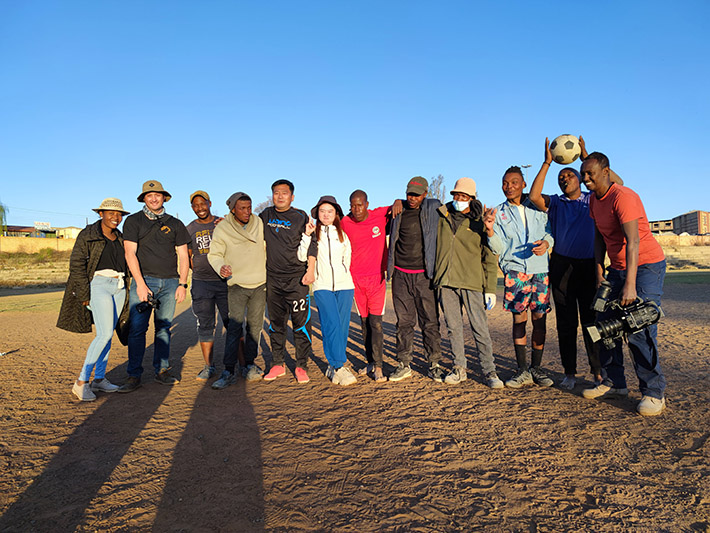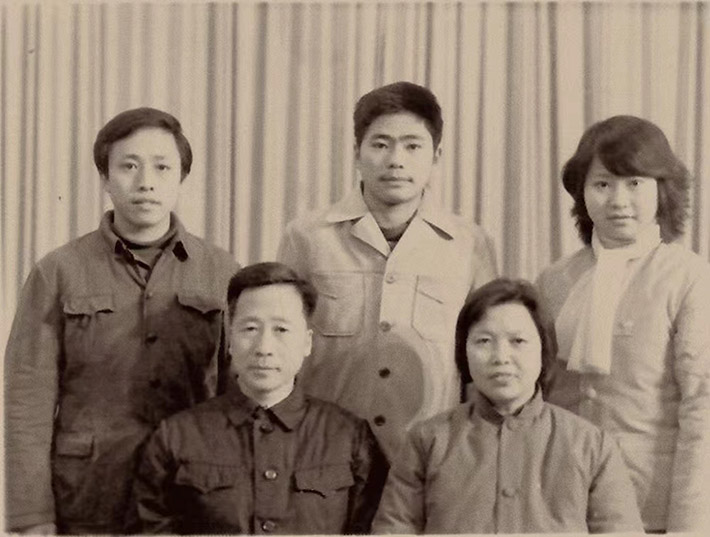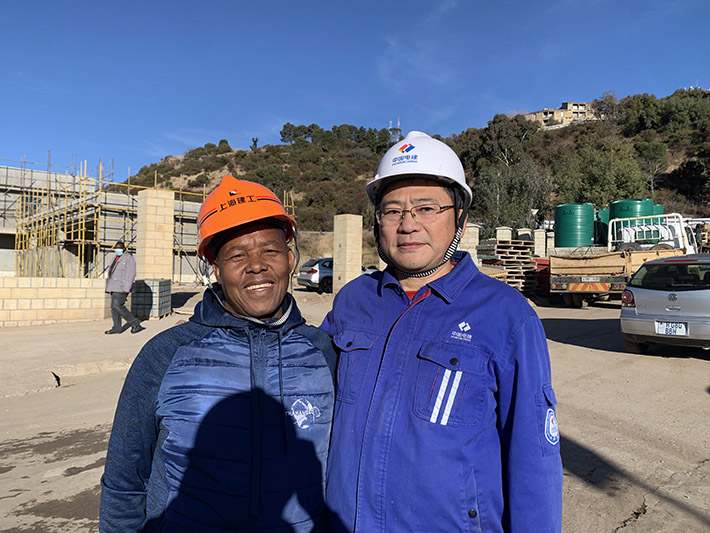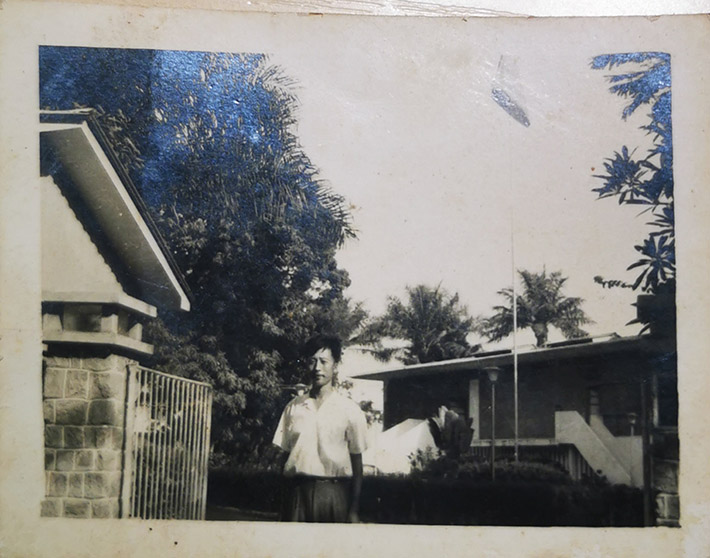|
||||||||||
| Home Nation World Business Opinion Lifestyle ChinAfrica Multimedia Columnists Documents Special Reports |
|
||||||||||
| Home Nation World Business Opinion Lifestyle ChinAfrica Multimedia Columnists Documents Special Reports |
| ChinAfrica |
| Architects of Friendship |
| Following their father’s footsteps, two brothers support Chinese aid efforts for Africa |
| By Xia Yuanyuan | VOL. 15 October 2023 ·2023-10-13 |

Zhao Tian’an (fifth left) poses for a photo with local workers in Maseru, Lesotho
Zhao Tian’an is the head of a Chinese construction project in Lesotho. His company, Zhongnan Engineering Corp., is building a new hospital on the original foundation of the Queen Elizabeth II Hospital, which has been out of service since 2011.
Zhao said his fascination with Africa comes from a family heritage. His father Zhao Yonglin participated in the construction of the People’s Palace in Guinea and the National Theatre of Somalia in the 1960s and 1970s, respectively.
“When I was young, my father often talked to us about Africa, and always with a smile on his face,” recalled Zhao. His father’s experience in Africa had a profound impact on Zhao and his elder brother. Both of them worked as architects and designed more than 10 key construction projects in African countries. Since the 1960s, two generations of Zhao family have left an indelible mark on the engineering work on the African continent.

A family photo of Zhao Tian'an (centre back) with elder brother Zhao Tianhu (left back), sister (right back) and parents (front)
Generational legacy
Even now, Zhao occasionally takes out his father’s diary and looks through it. In the diary, his father recorded details of his daily work in Africa. This diary is a valuable asset to him and inspires his current foreign aid journey in Africa.
In 1965, when Zhao was two years old, his father, as one of the first construction engineering experts in China to aid Africa, went to Guinea to preside over the construction of People’s Palace.
“He used to tell me what it was like, and I also learned from his diary what the living conditions were like in the 1960s. They had to figure out how to get electricity and water, like finding a generator, or drilling a well,” Zhao told ChinAfrica.
As the person in charge of the structural design of the palace, Zhao Yonglin solved a fundamental problem that European experts were unable to solve. The country is extremely hot. Entering the construction area for inspection was like going into a steamer. He overcame many difficulties, solved the problem of uneven settlement of the foundation, and ensured the structural safety of the building. The building was officially put into use after its completion in 1969 and was known as the Pearl of the Atlantic Ocean.
From 1973 to 1976, Zhao Yonglin went to Somalia and helped to design the country’s National Theatre.
“Whenever I think about how my father crossed the ocean and visited Africa more than 50 years ago, I am filled with emotion. They overcame difficulties to aid Africa, won the respect of the African people, and established a monument to China-Africa friendship,” Zhao Tian’an said. The father’s story inspired his two sons to embark on the road of aiding Africa.
Zhao Tian’an believes that in his father’s period, China provided aid to build national infrastructure such as city halls and grand theatres. This kind of assistance could safeguard national sovereignty and independence; but building schools and hospitals was seen as a more effective means of assisting African people in their independent development. Therefore, he and his brother mainly participated in the construction of hospitals and schools in Africa.
In 2010, as a senior engineer of the Hunan Provincial Architectural Design Institute and leader of the foreign aid expert team, his older brother Zhao Tianhu went to Ghana as a member of the Chinese inspection team, and was responsible for the preliminary design work for a hospital in Ghana. In December 2013, he also went to Kenya, Tanzania and other countries several times to design schools for children in impoverished areas.
The brothers believe that supporting African educational facilities is of greater significance than providing other materials and equipment. It will help African countries to overcome the development bottleneck of insufficient talent and promote comprehensive development of Africa’s economy and society.

Zhao Tian'an with a local worker at the construction site of the Queen Elizabeth II Hospital in Maseru, Lesotho
Gift of health
In December 2021, Zhao Tian’an visited Maseru, the capital of Lesotho, on a two-year aid mission intended to build a brand-new general hospital and an eye clinic for the city, which is an outcome of the Johannesburg Summit of the Forum on China-Africa Cooperation held in 2015. It is China’s single-largest project involving people’s livelihood in Lesotho.
The conditions at the project construction site were less than ideal. Zhao Tian’an and his colleagues worked together to protect themselves from COVID-19 pandemic and prevent security risks, while insisting on ensuring the quality of the construction site.
“We have designed an oxygen producing centre, so we can produce oxygen right here. Most hospitals here don’t maintain oxygen tanks. The tanks are shipped from South Africa or countries even farther, which is costly, not to mention the waste of time,” Zhao said.
Phaaroe Pherekhonga, assistant manager in the technical team, said that the new hospital will reduce the need to transfer people to hospitals out of the country. “Having this hospital means people can be treated within the country,” he said.
The 200-bed hospital was built through the donation of 400 million yuan ($54 million) from the Chinese government. On completion, it is expected to help at least 400,000 people in Maseru and other districts. The hospital will be completed by the end of this year and handed over to the government in the first quarter of 2024.

Zhao Yonglin in Chinese Embassy in Guinea in June 1965
Close bond
“Mokhotsi, oaka,” this is the first Lesotho sentence Zhao Tian’an learned, which means “we are friends.” During his missions in Africa, Zhao Tian’an has made many local friends.
The Chinese architect’s engagement with Africa started in 2008, when he participated in a residential project sponsored by the Gaddafi government in Zuwarah, Libya.
Libya sits on the southern coast of the Mediterranean. Its architecture has a remarkable Roman trait. Back then, the Gaddafi administration announced a 5,000-unit housing project in the coastal city of Zuwara, and the houses were promised to low-income families for free. Zhao Tian’an arrived there in 2008.
“We made the plan, did the research and talked to local planning officials. I worked with a local engineer, we communicated for three months, and everything was in place when in 2011, the first Libyan civil war broke out,” Zhao Tian’an said.
After the war broke out, militant groups and rebels started to show up. They knew Zhao Tian’an’s team had equipment, vehicles, laptops and cash. “One night, they just broke into the camp and took everything away. It was Libyan colleagues who helped us, using their own vehicles to evacuate us out of the city quickly and safely. I feel grateful to them,” Zhao Tian’an recalled.
The free housing project in Zuwarah was never finished due to the war. The abandoned construction was gradually falling apart with no hope of being ever occupied. But the days he spent in the country with local people will always remain in his mind. “I still remember they love football; we often played at a nearby pitch.”
This year marks the 10th anniversary of the Belt and Road Initiative (BRI). Zhao Tian’an said that under the BRI, he hopes to have the opportunity to work again in Africa, contribute to the construction projects under the BRI, and serve as a bridge for China-Africa people-to-people exchanges.
|
||||||||
| About Us | Contact Us | Advertise with Us | Subscribe |
| Copyright Beijing Review All rights reserved 京ICP备08005356号-5 京公网安备110102005860号 |